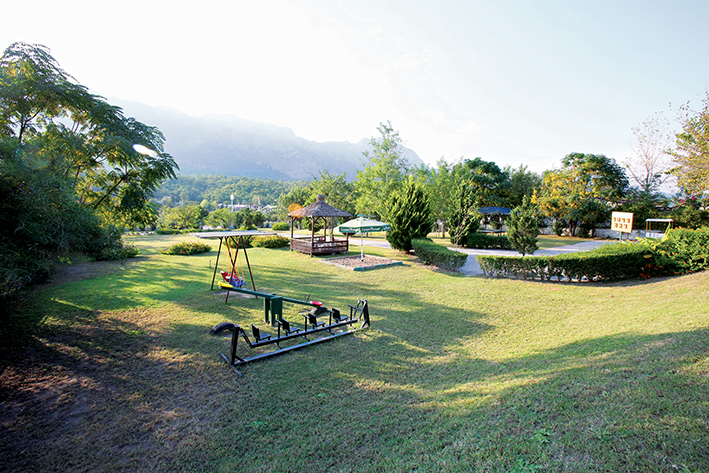OUR GARDENS
This region of the Antalya province it famous for its extents orange gardens. Until the 1980 when a project of the World Bank started to support the development of tourism, Kemer was a small village surrounded by beautiful citrus groves, the sea and the Toros Mountains.
The
Main Garden, the area where the hotel was build was also one of these orange gardens. During the construction we tried to keep as many of the old trees as possible, that is why you see some of them almost leaning to the walls or balconies. The trees maybe old, but they still give us plenty of fruit and a lot of joy during the time of their blossom in early spring.
When walking from the entrance gate towards the swimming pool of the
Relax Garden you may still get the real feeling of being in the middle of a citrus garden. The trees on both sides are mainly oranges, but there are also Bitter Orange, Mandarin and even some Lemon trees in this garden. Pomegranate actually does not belong here, but we have planted some because of their beautiful flowers and wonderful fruits. In contrast to the citrus trees the pomegranate drops leaves during the winter months. The entrance to Relax Garden is available for adults 16+. The garden is opened from 15th of May till 15th of October.

And then there is the
Beach Garden, about 1.1 km from the hotel and very different from, as there are only few trees, some all mulbery and others. In this garden in the back of our private beach section there is a playground for small children, the garden chess and also table tennis. Normally the beaches of Kemer consist of pebbles, but this area is very different with a dune of fine sand, on which the beach bar is located. From there you have a wonderful view over the Antalya bay and Kemer.

Our beach covers together with the bar and garden an area of about 4,000 square meters and features facilities such as shower, toilets, changing cabin, sunshades, sun loungers and mattresses.
The waterfront has pebbles.
 About Citrus Trees
About Citrus Trees
The citrus trees belong to the single genus Citrus and remain almost entirely interfertile. This means that there is only one super species that includes grapefruits, lemons, limes, oranges, and various other types and hybrids. The fruit of any citrus tree is considered a hesperidium (a kind of modified berry) because it has numerous seeds, is fleshy and soft, derives from a single ovary and is covered by a rind originated by a rugged thickening of the ovary wall.
The orange tree is an evergreen, flowering tree, with an average height of 9 to 10 m. Another citrus species is the
Bitter orange (Citrus aurantium), also known as sour orange and marmalade orange. Also we are growing some Bergamot oranges (Citrus bergamia Risso), but the trees are still rather small.
Bergamot has a rather controversial history. Some say it originates from Northern Italy, taking its name from the small town of Bergamo where it was discovered, others state it originated in India. Whatever its history, there is no disputing that Bergamot has been used for years because of its sweet, citrus scent with spicy undertones. Popular with perfumers for centuries, Bergamot has an uplifting, energizing scent, which also makes it perfect for aromatherapy.
Bergamot also gives Earl Grey tea its unmistakable and unique flavour, which makes it a favourite among tea lovers everywhere. The greatest use of sour oranges as food is in the form of marmalade and for this purpose they have no equal. In Turkey a delicious marmalade is made of Bergamot and the essence is used as flavour for tea (three drops on a lump of sugar for 100 g tea)